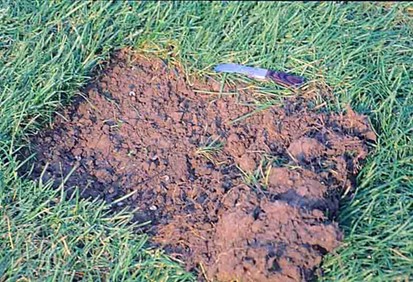Issue 8, August 4, 2022
White Grubs
White grub is a common name for the larvae of June beetles, chafers and Japanese beetles. They are white, C-shaped larvae, about 1 inch long and have 6 jointed legs attached close to their small brown head capsule. The grubs can be found in the first 8 inches of soil beneath turfgrass where they feed on grass roots. Excessive root feeding by white grubs can leave turfgrass poorly anchored to the soil and can result in brown patches in a lawn that can be pulled back like a rug. This can impact the aesthetics of a lawn and, in some cases, can make sports fields less safe for children and athletes.

White grub, Alton N. Sparks, Jr., University of Georgia, Bugwood.org.
Scouting is the most important step in determining whether a treatment is necessary or economical. August is the best time to scout for grubs because young grubs are hatching and beginning to feed on grass roots. To scout for grubs, choose a location in the turfgrass that is near pavement and away from trees. Cut a 1 sq.ft. patch of turfgrass and roll it back to expose the grubs below. If you find 10 – 12 grubs or more in those patches, you have enough insects to cause significant injury and can apply a treatment to the turfgrass.

White grub scouting, Phil Nixon, University of Illinois at Urbana-Champaign.
Chemical Controls:
Neonicotinoids (Merit, Arena, Meridian) are systemic insecticides, meaning they are taken up by and transported within the grass plants. When grubs feed on grass roots they take in the insecticide and are killed. These systemic insecticides can remain active within the turfgrass for up to 3 months. Because these products are transported within the plant, they have the potential to harm pollinators visiting treated plants. It is important to avoid applying neonicotinoids to flowering plants (including clover and weeds) to prevent pollinator exposure.
Trichlorfon (Dylox) is an effective and short acting treatment for white grubs. It can be purchased as a granular formulation that must be incorporated, watered-in to the turfgrass.
Chlorantraniliprole (Acelepryn) is a more selective insecticide that can provide control for white grubs and some caterpillars that feed on turfgrass but has a lower risk of harming pollinators like bees. It can be applied as either a spray or granular formulation.
If a treatment without synthetic active ingredients is preferred, biological or cultural controls can be used.
Biological Controls:
GrubGone!® is a microbial product that can be an effective option in controlling white grubs. The active ingredient, Bt galleriae (Bacillus thuringiensis galleriae), is a soil microbe that damages the gut of beetle larvae when it is consumed.
Cultural Controls:
Another strategy is to make turfgrass less attractive by reducing irrigation during late July and early August. At this time, adult beetles are actively mating a depositing eggs and well-irrigated turfgrass is the most attractive location for egg-laying. This is the safest and cheapest option but may result in some browning from lack of water during the hottest part of the summer. This option may not be possible in locations like golf courses, where green grass is required.
Author:
Sarah Hughson